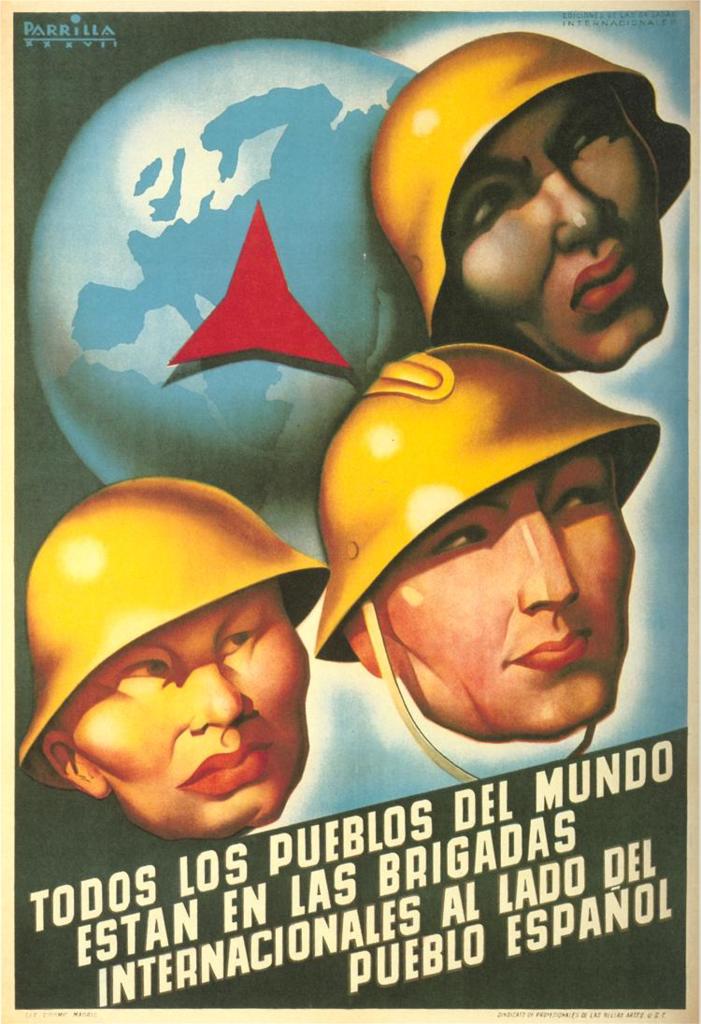

 字體:小 中 大
字體:小 中 大 |
|
|
|
| 2008/09/27 03:51:02瀏覽1196|回應0|推薦11 | |
白求恩有兩段耐人尋味,一是他的婚姻,一是在西班牙,說過婚姻,今天講西班牙,其實就算西班牙,也還是離不開婚姻。 《向左轉》 白 1935 去莫斯科開醫學會,完了參觀社會主義標榜的公醫和健保,以及非盈利導向的公共衛生制度, 1930s 年代,是兩次大戰之間,歐美右派主導的《無反省資本主義經濟》最顛峰時段,賺錢為目的是制度問題,已經離開個人醫德與 Humanity 討論。 為別於西歐右派,蘇聯標榜的無產階級優越性,就集中推銷此一賣點 ! 如果社會的進化,將有賴於資本家自覺與反省,而主動照顧貧病交迫的弱勢,這完全是癡人說夢的事 ! 在歐美知識界即使是最溫和的人道主義者,也不作如此幻想,何況是每天在大都市里為有病無銀的苦力開辦義診的白求恩呢 ? 蘇聯端出來的樣板,其實是掩飾均貧的表演(短線炒作 ? ),但已大大感動了白這樣對資本主義失望的好人。白是十字街頭的人道主義者,不是象牙塔里的蛋頭。他乃加入共產黨,(這一段頗多爭議,有史學家甚至懷疑他的黨籍),然後很快去了西班牙。 對於後來挑剔式的批評,說白是個人主義,自高自大自我膨脹,自動請纓去西班牙實際是把自己看成耶穌……,好!就算白是 Grandiose--- 自我膨風,個人英雄主義,人家至少 《 我不入地獄,誰入地獄 》 ,那些耍嘴皮的看客呢?喝茶看報,口水高射砲,你們救了幾個人呢? 《兩大弱點》 與白同往西班牙的同事兼仰慕者, Toronto 醫師 Allan, 後來回憶:白個性有《壞脾氣》和《懶得解釋》兩大傾向,酒精和女人是他的兩大弱點。(尋常傳記將他和 Frances 的離異歸罪於科學,其實是為賢者諱……)。反正白之聰明與器識,超越同儕太多,周遭說他傲慢和喜怒無常其實不令人意外, Dr. Allan 說他在加在西都《對同僚極壞而對病人極好》 (*1) 。 他的流動式輸血隊 Mobile blood transfusion 創制,其貢獻不但被西班牙戰地肯定而且進了醫學史(*2),但是為了更準確計算供血路線和時間,他手繪戰地地圖,違反保密規定。在杯弓蛇影的戰地 (*3) ,他被安全人員鎖定,再加上言語不通,酒精跟女人,浪漫主義天性,他終於被迫走路……。 白此時距二度離婚已五年,入(共產)黨,請纓赴義,都看得出來 < 世紀末式 > 的自我放逐,在戰地一逮到機會就搶著上前線(白在進醫學院前曾應召入伍參加歐戰《 1914-1918 》,在法國前線服役)一副恨不能馬革裹尸的德行,去一般理解的醫生形象太遠。他又自視太高懶得解釋,當然啟人疑竇。 《陳卷出土》 他再度失去 Frances ,此生緣盡已成定局,看待男女關係,變成“隨興”的施明德……。打他小報告的是共產黨《內檢細胞》,這報告在共和政府被叛軍消滅後,塵封莫斯科 54 年, 蘇共垮台後曝光(1991) : (1) 有一個瑞典的 blonde 艷娃,原為 dancer ,在西班牙當 《 導遊 (?) 》 ,自稱記者,採訪 Red Cross 的 mobile blood transfusion team ,專訪火爆浪子帥哥白求恩。他們倆天雷鉤動地火,愛得放浪形骸。不知道這女早被反間肅諜組盯上,她早被懷疑與法西斯關係密切。 (4 * ) (2) 為給白台階,在形式上他是自行辭職,說詞是《活動輸血急救站的理論及實用,都已組建完成,白的培訓與領導角色也應結束。》 (3) 他返回美加,以身作證,到處演講。在共和政府倒台前,兩次請求准許返回西班牙前線,都被拒絕。 《如是我聞》 白的故事教育我們 : 歷史的人事時地是三度空間,如果只看教科書和宣傳海報,是清光飲食男女只剩臉譜的皮相,皮相只是電影海報和唱片封套,所以可以全忠全孝,盡善盡美,勇者可以刮骨療毒,不理會 neurology 的奇蹟,義者可以坐懷不亂,不理會 psychology 的問號。白死後毛為文紀念,意在《機會教育,砥厲戰志》。好,可以上升到《中國人民不忘本,白的血不白流》,壞,可以下降到《徹底運用白死亡的剩餘價值》。我們卻在書縫裡讀出大時代旋渦中,人性的曲折婉轉。太行山腳,有個孤獨的醫生,埋骨異域,他的名字叫:諾爾曼‧白求恩。 (*1) 醫門行走多年,乍聽 Allan 的說法,實在令人熟悉的會心一笑!《東海而有聖人出,其心同其理同,西海而有聖人出,其心同其理同。》全世界的醫學院都一樣! (*2)白求恩在醫界聞名不是因為他來中國,也非胸腔外科治TB,而是對《活動輸血隊》( mobile blood transfusion team) 的理論與實踐。因為西班牙內戰在醫學史上的意義,首推輸血在外科手術的大量使用,而白求恩正是解決缺血瓶頸的發明人。醫學史上1914人類才首度成功non-direct transfusion,歐戰中因大量傷患,血庫概念逐步在摸索中產生,1936西班牙內戰傷患的質和量皆隨武器晉級而爆天量。缺血乃躍升為手術成敗關鍵之首。 (*3) 白和海明威,卡繆,喬治·歐威爾,等等來自 53 個國家,後來聞名國際的大明星,總共約 3 萬8千人都被編入西班牙的《國際縱隊( international brigade )》。這裡面甚至還有幾個中國人(中國共產黨旅德支部),現在馬德里還有紀念公墓……。正因為內戰本來就是零和遊戲,自始就難脫爾虞我詐的性質,又有左右兩大國際陣營的插手,潛伏滲透也亂七八糟。 (*4) 這位瑞典辣妹對法西斯並無好感,被盯上的原因 , 一是自由派的浪蕩作風(不合戰地規格!) , 二是瑞典血統 ———— 在南歐拉丁人眼里,瑞典語跟德語根本是堂表一家親。左邊的人疑她右,右邊人恨她左,內戰從來就如此。西班牙法西斯分子取得政權後,她就離開了西班牙,做為難民到了墨西哥, 30 年後死在那裡。(墨西哥幾乎是西班牙流亡的首選)。
《后記:》 毛《紀念白求恩》雖在 1939 寫成,卻是在 1965 才重新推出,拉高為全面學習的樣板。時間背景說明工具論的算計。 血統問題也困擾《外省人》,費希平為了民主而接受反蔣統戰,卻在臺獨淫威前忍無可忍而決裂,好歹比等而下之的謝志偉見多識廣。謝像文革中有黑五類陰影的紅衛兵,心虛自己血統不純被揪出,須加倍瘋狂地把自己爹媽往死里鬥,以博無知看客一燦! 以西班牙之標準,臺灣目下進行的是《準內戰》。
這是一張共和政府設計的國際縱隊海報,白求恩和海明威都是編在這個縱隊里。 有趣的在白黃黒三張臉,這張黃臉對黃種人之醜化(恕我主觀!請看旁邊那白人),跟好萊塢早年電影里的細眉窄眼塌鼻一個刻板調調兒(stereotype),問題是這張海報明明是要對黃種黑種人示好,是要對我們表示感激親善的……。這一張照片,等于已經把斯賓塞 ( Herbert Spencer ) 的比較社會學全說完了!
《對病人極好,對同僚極壞》的白求恩. Medical Research and New Methods of Treatment Dr. Norman Bethune, assisted by Henning Sorensen, performing a transfusion during the Spanish Civil War, 1935-1938. In addition to such organizational improvements, important medical research with practical military applications was ongoing during the interwar years. One of the most promising areas of study focused on chemical treatments of illness and injury. In the mid-1930s it was discovered that sulphanilamide and other sulphonamide derivatives retard the growth of bacteria and thenceforth sulfa (or sulpha) drugs were widely used to prevent or treat infection in wounds. Sulfa could be given by mouth or used as a powder applied directly to wounded tissue. Experiments with penicillin treatment were conducted early in the war, and by the opening of the Second Front it had come to be administered more systematically, with patients receiving an initial dose at a Casualty Clearing Station or Advanced Surgical Centre with subsequent doses during evacuation and while in hospital. While important work on blood products like plasma and serum was undertaken at various Canadian universities and the National Research Council, other Canadian projects focused on the particular needs of the air force. With the country's only decompression chamber, scientists at the University of Toronto studied the effects of high-altitude flight on aircrew. Meanwhile, research into the effects of gravity-or G forces-sought to resolve problems of impaired blood circulation resulting from centrifugal force which caused fighter pilots to experience blackouts, loss of vision, and unconsciousness during high-speed manoeuvres such as pulling out of a dive. One of the key figures was Wilbur Franks, who worked under Dr Frederick Banting at the University of Toronto in developing the Franks flying suit. The suit was lined with fluid to counteract the displacement of blood by G forces, and was used operationally in the Royal Navy's Fleet Air Arm although it was not accepted by the air force. Medical research was therefore able-somewhat paradoxically-to improve methods of treating the wounded even as it devised more efficient means for military personnel to do their jobs, perhaps inflicting death on others in the process. |
|
| ( 時事評論|人物 ) |





 在西班牙的野戰醫院操作輸血。
在西班牙的野戰醫院操作輸血。





